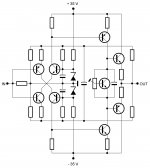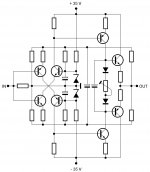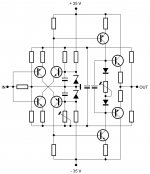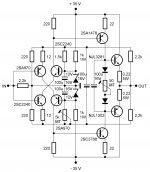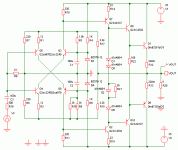I would much prefer two capacitor-banks one bank driving the output and one bank with diode separation driving the other stages...then PSU sag will only affect the output stage.. to me this clearly improves the amplifier...
I agree but please draw these diodes from the main rails and add DC smoothing caps for the input stage, than you will see that in this amp this is really not necessary, since we only have to supply DC current to one - zener potential and this can be done in the same manner like you mentioned, just with adding more capacitance in parallel to zener diodes. 😉
I have found this supplier to be dependable up to this point. I hope to have the transistors matched in one week for those who are interested. I will confirm authenticity and give numbers when finished. I also look forward to building this amp as well.
SSA complete BJT version
As we agreed with Nico that there should be three versions of SSA (Simple Symmetrical Amplifier), regarding output buffer, presented for listening tests:
- BJT driver/BJT output
- BJT driver/MOSFET output
- MOSFET driver/BJT output
Here is my sch proposal for the first one from the list. I intentionally left blanks for the values so we can have something to discuss about here. My only suggestion would be about the currents: input pair 2-5 mA, driver current 15-20 mA, output current 100-250 mA. Defining these currents will lead to proper resistor values, types of BJT's, etc. Any comments? 🙂
As we agreed with Nico that there should be three versions of SSA (Simple Symmetrical Amplifier), regarding output buffer, presented for listening tests:
- BJT driver/BJT output
- BJT driver/MOSFET output
- MOSFET driver/BJT output
Here is my sch proposal for the first one from the list. I intentionally left blanks for the values so we can have something to discuss about here. My only suggestion would be about the currents: input pair 2-5 mA, driver current 15-20 mA, output current 100-250 mA. Defining these currents will lead to proper resistor values, types of BJT's, etc. Any comments? 🙂
Attachments
How should the 4 input devices be thermally coupled to gain best resistance to varying output with variations in ambient temperature and operational dissipations?
Thinking about Roender's amps, he used some diodes to provide some temperature compensation for the input stage. Can we gain similar performance advantages doing something similar?
Thinking about Roender's amps, he used some diodes to provide some temperature compensation for the input stage. Can we gain similar performance advantages doing something similar?
Input stage is in a perfect temperature balance regarding symmetry if the two input BJT's are in thermal contact - tested. Cascodes are non critical, drivers should be separated from the main heatsink - small, almost constant power dissipation, outputs are compensated with Vbe multiplier, so thermally looking everything is in order. 😉
Last edited:
I have completed the L-MOSFET with drivers. It sounds really good, clean, open and dynamic. It is stable and can operate into dubious loads. Again my compliment Lazy Cat it is a job well done.
Regards
Nico
Regards
Nico
SSA sound
Thanks. Yes, yes, ... the sound from this simple schematic is only what it matters. It is so neutral, transparent, dynamic, easy flowing, like there is nothing in between source and the speaker, wire with the gain. Enjoy Nico!
Thanks. Yes, yes, ... the sound from this simple schematic is only what it matters. It is so neutral, transparent, dynamic, easy flowing, like there is nothing in between source and the speaker, wire with the gain. Enjoy Nico!

Nico, could you please post the schematic that you are using right now ? That is the version i like most by intuition.
Also some info on the bias current used, test rails potential, and the power it achieved for 0.1% THD on 8 & 4 Ohm, will be welcome.
Member
Joined 2009
Paid Member
Offset trimmer was missing, now output DC OK. 😉
I like it in BJT-only form, this has every chance to be a popular circuit.
I find the way you have drawn the schematic adds to the interest for me, not sure I can explain, but it looks nice 🙂
These values are of course discussable, cause now I see that the second stage (driver) voltage gain should be significantly higher, so substantial reduction of 22 ohm emitter resistance must be done. Recalculation in progress ... 😀
These values are of course discussable, cause now I see that the second stage (driver) voltage gain should be significantly higher, so substantial reduction of 22 ohm emitter resistance must be done. Recalculation in progress ... 😀
A good option would be to simply implement a double EF
as output stage , reducing THD efficently , as displayed
in the following graph.
IQ is about 0.42A in both cases.
Attachments
A good option would be to simply implement a double EF
as output stage , reducing THD efficently , as displayed
in the following graph.
IQ is about 0.42A in both cases.
I know but than we are a little out of the concept. 😀
Please recheck THD with these new values. 😉
Attachments
I know but than we are a little out of the concept. 😀
Please recheck THD with these new values. 😉
This is better but still more than 20db higher THD
than with a double EF final stage.
The VAS is really too much loaded and this ruin this circuit
capabilities wich are quite good given the schematic simplicity.
Good work , Lazycat , anyway...😉
It looks in this concept with 8 transistors, lateral MOSFET output's would give the best THD figures, loading the VAS less than other versions.
MOSFET driver is another option, maybe ... the best solution of this simple concept lies in the right driver/output configuration, as we have already discussed here. 🙄
MOSFET driver is another option, maybe ... the best solution of this simple concept lies in the right driver/output configuration, as we have already discussed here. 🙄
Last edited:
How about a BJT - Lateral Mos Szikley compound ? I really would prefer that the mosfets drive the speaker from the drain but i am not a power amplifier specialist.
- Status
- Not open for further replies.
- Home
- Amplifiers
- Solid State
- Simple Symetrical Amplifier
